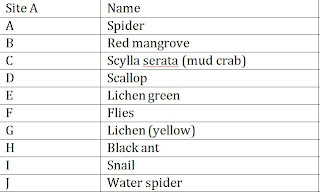Shortly after investigating the
mangrove ecosystem, the bus took us to the rocky shore, where we were able to
explore the beach. The rocky shore was surrounded by jagged rocks, with intense
sunlight. We measured the wave frequency per minute using a timer, and the wind
was blowing on the direction of north east. The temperature of the ecosystem
was measured using a thermometer, and the result was 31 degrees Celsius. In
addition to the abiotic factor, the biotic factor was also measured by
determining the slope of the rocky shore, as the ecosystem of the rocky shore
isn’t flat. Quadrats were then laid and the abundance of the organism was
counted.
We
worked at a side where the waves crashed against the rock. The ocean near the
shore had nothing much to offer. On the other hand, the organisms teemed the
rocks that the waves crashed against. Barnacles, in all sizes and shapes were
especially numerous and populated the rocks. Even when the waves crashed
against the rocks, the barnacles held on, and was actually great in numbers
near the waves compared to rocks that wasn’t anywhere near the ocean. In this
ecosystem, human interaction has impacted it. There was a pathway towards the
rocky shore, and several boats floating near the rocky shore. These may have
affected the distribution of organisms in this ecosystem.
Figure 1: Kite Diagram of the
Biotic Factors in Rocky Shore
Figure 1 shows the kite diagram
made using the abundance of the organisms in this ecosystem. 5 quadrat was laid
after the slope of the rocky shore has been measured. Barnacles were heavily
populating the rocks near the ocean waves, which is signified by the large kite
on quadrat 1 and 2 for barnacles on the kite diagram. Periwinkles on the other
hand, were greater in numbers on quadrat 4, where it was pretty high up
compared to the quadrat where barnacles were numerous. There were a few to none
limpets around, as the area was heavily populated by the barnacles. Barnacles
are able to clamp themselves onto the rocks, even strong enough to resist the
force of the waves crashing the rocks. These adaptation allowed them to
flourish where other organisms can’t.
On a semi-unrelated-note:
Biology HL students gathering for a photo :)






